The AMD Radeon R9 Fury Review, Feat. Sapphire & ASUS
by Ryan Smith on July 10, 2015 9:00 AM ESTCompute
Shifting gears, we have our look at compute performance. As compute performance will be more significantly impacted by the reduction in CUs than most other tests, we’re expecting the performance hit for the R9 Fury relative to the R9 Fury X to be more significant here than under our gaming tests.
Starting us off for our look at compute is LuxMark3.0, the latest version of the official benchmark of LuxRender 2.0. LuxRender’s GPU-accelerated rendering mode is an OpenCL based ray tracer that forms a part of the larger LuxRender suite. Ray tracing has become a stronghold for GPUs in recent years as ray tracing maps well to GPU pipelines, allowing artists to render scenes much more quickly than with CPUs alone.

For LuxMark with the R9 Fury X already holding the top spot, the R9 Fury cards easily take the next two spots. One interesting artifact of this is that the R9 Fury’s advantage over the GTX 980 is actually greater than the R9 Fury X’s over the GTX 980 Ti’s, both on an absolute and relative basis. This despite the fact that the R9 Fury is some 13% slower than its fully enabled sibling.
For our second set of compute benchmarks we have CompuBench 1.5, the successor to CLBenchmark. CompuBench offers a wide array of different practical compute workloads, and we’ve decided to focus on face detection, optical flow modeling, and particle simulations.
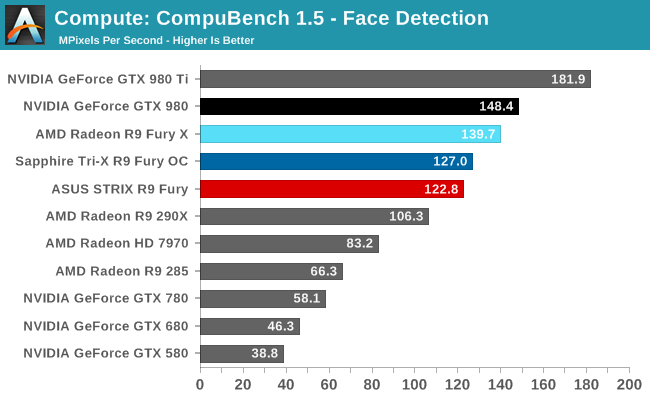
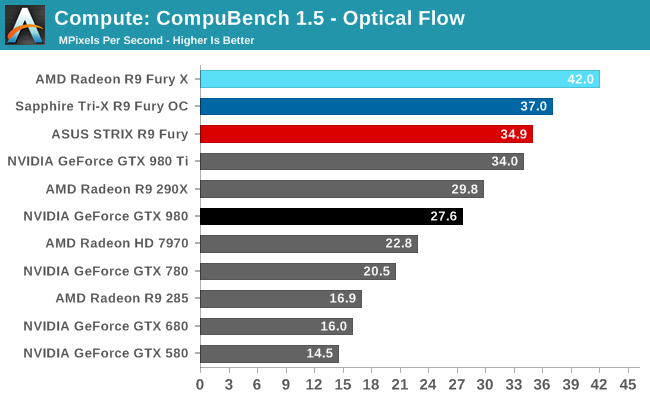

Not unlike LuxMark, tests where the R9 Fury X did well have the R9 Fury doing well too, particularly the optical flow sub-benchmark. The drop-off in that benchmark and face detection is about what we’d expect for losing 1/8th of Fiji’s CUs. On the other hand the particle simulation benchmark is hardly fazed beyond the clockspeed drop, indicating that the bottleneck lies elsewhere.
Our 3rd compute benchmark is Sony Vegas Pro 13, an OpenGL and OpenCL video editing and authoring package. Vegas can use GPUs in a few different ways, the primary uses being to accelerate the video effects and compositing process itself, and in the video encoding step. With video encoding being increasingly offloaded to dedicated DSPs these days we’re focusing on the editing and compositing process, rendering to a low CPU overhead format (XDCAM EX). This specific test comes from Sony, and measures how long it takes to render a video.
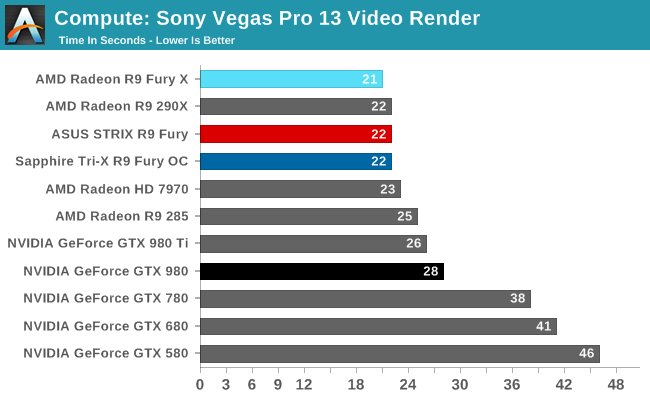
At this point Vegas is becoming increasingly CPU-bound and will be due for replacement. The R9 Fury comes in one second behind the chart-topping R9 Fury X, at 22 seconds.
Moving on, our 4th compute benchmark is FAHBench, the official Folding @ Home benchmark. Folding @ Home is the popular Stanford-backed research and distributed computing initiative that has work distributed to millions of volunteer computers over the internet, each of which is responsible for a tiny slice of a protein folding simulation. FAHBench can test both single precision and double precision floating point performance, with single precision being the most useful metric for most consumer cards due to their low double precision performance. Each precision has two modes, explicit and implicit, the difference being whether water atoms are included in the simulation, which adds quite a bit of work and overhead. This is another OpenCL test, utilizing the OpenCL path for FAHCore 17.
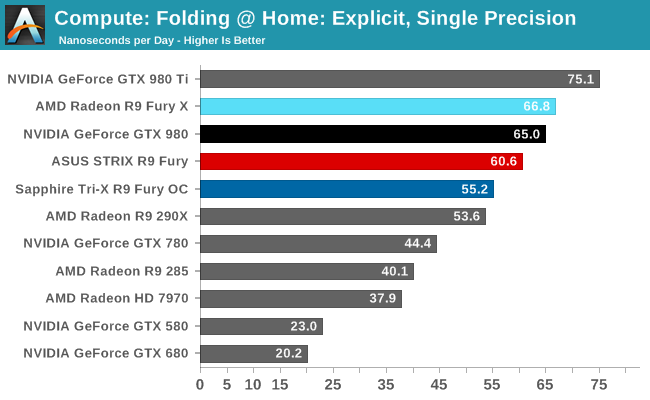
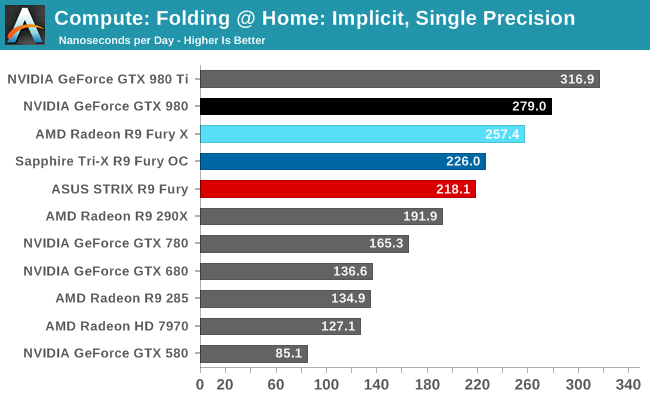

Overall while the R9 Fury doesn’t have to aim quite as high given its weaker GTX 980 competition, FAHBench still stresses the Radeon cards. Under single precision tests the GTX 980 pulls ahead, only surpassed under double precision thanks to NVIDIA’s weaker FP64 performance.
Wrapping things up, our final compute benchmark is an in-house project developed by our very own Dr. Ian Cutress. SystemCompute is our first C++ AMP benchmark, utilizing Microsoft’s simple C++ extensions to allow the easy use of GPU computing in C++ programs. SystemCompute in turn is a collection of benchmarks for several different fundamental compute algorithms, with the final score represented in points. DirectCompute is the compute backend for C++ AMP on Windows, so this forms our other DirectCompute test.
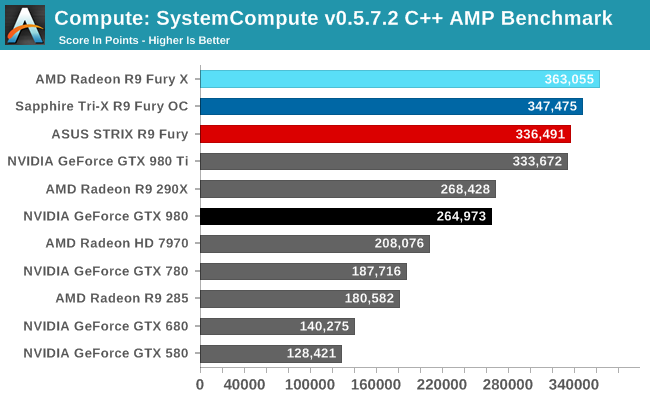
As with our other tests the R9 Fury loses some performance on our C++ AMP benchmark relative to the R9 Fury X, but only around 8%. As a result it’s competitive with the GTX 980 Ti here, blowing well past the GTX 980.










288 Comments
View All Comments
Gigaplex - Saturday, July 11, 2015 - link
"We do not compare OC'd cards."Well, technically you do, but usually only when there's no reference card. Problem is, if one vendor decides not to do a reference card, the custom cards get an advantage when comparing against reference cards of another vendor. We're only asking that you include a custom card as well in these situations.
Ryan Smith - Saturday, July 11, 2015 - link
Whenever there isn't a reference card however, we always test a card at reference clockspeeds in one form or another. For example in this article we have the ASUS STRIX, which ships at reference clockspeeds. No comparisons are made between the factory overclocked Sapphire card and the GTX 980 (at the most we'll say something along the lines of "both R9 Fury cards", where something that is true for the ASUS is true for the Sapphire as well).And if you ever feel like we aren't being consistent or fair on that matter, please let us know.
Ranger101 - Saturday, July 11, 2015 - link
Nvidia still has the fastest high end offering in the 980TI. Isn't that enough? Sometimes you just have to take a solid AMD win on the chin.Socius - Saturday, July 11, 2015 - link
Except a card that is $100 more than the GTX 980, and slower than it when OC'd, isn't a "win" by any means. Unless we're treating AMD like they're in the special Olympics and handing them a medal just for showing up.FlushedBubblyJock - Wednesday, July 15, 2015 - link
I know, rofl.The amd fanboy forgets pricing suddenly, when their master and god reams the backkside wallet holder, suddenly price is removed entirely from the equation !
It's no secret amd fanboys are literally insane from their obsession.
Socius - Saturday, July 11, 2015 - link
Really? The Fury is ahead of the GTX 980 and is a comparable value proposition? Yet again you run overclock benches with the Fury without showing the same being done on that GTX 980. I have no idea why you follow this policy of no cross-vendor OC performance comparisons as most people geeky enough to be reading this website would be interested in seeing final performance stats that they can achieve on a stock card, with basic overclocking. So if you have a card like the Fury that overclocks a whopping 5%, compared to a GTX 980 that can overclock 25-40%, yeah...you're doing a disservice to your readers by withholding that information. Especially when you don't even bring it up in your conclusion.Paid by AMD much? I never thought I'd have to look at any reviews other than those from Anandtech. But this website has been playing it too cautiously, and without the ultimate intent of showing best overall/actual performance and value to their readers.
Seriously Ryan, I'm disappointed. I don't see why there would be an issue with showing a comparison between max OC between, oh, let's say, the Asus R9 Fury STRIX and the...Asus GTX 980 STRIX. Would be a pretty darn fair comparison of 2 different cards and their performance when given the same treatment by the same manufacturer.
I don't know why I even bother commenting anymore.
Orthello - Saturday, July 11, 2015 - link
I think it would be great to see an OC vs OC comparison, the problem is its unfair to do so now for Fury as there is no voltage control yet like there is for Nvidia Cards.When afterburner / trixx etc support the voltage control for Fury then we can really get the real max oc vs max oc , unless you are talking about overclocks at defualt voltage which makes no sense.
Socius - Saturday, July 11, 2015 - link
At the end of the day, this is the product they've placed in people's hands. But even without voltage increases on the Nvidia side, you should be able to OC to around 1400MHz at least, when on a custom cooler design like the STRIX model, for example. But I don't think Ryan cares about what's "fair." That's why he's putting these custom boards up against the reference NVidia designed/clocked GTX 980. Because that's somehow a fair comparison. =DFlushedBubblyJock - Wednesday, July 15, 2015 - link
Don't worry, the insanity is so rampant that if amd ever gets an overclock going- we will never hear the end of it - "OVERCLOCK MONSTER !!!!"On the 290 series amd fanboys were babbling all over the internet that nearly every amd card hits 1300 or 1350 "easily".
Of course they were lying those were rare exceptions, but hey...losing is hard on the obsessed.
Now we know the nvidia flagship core is a real monster overclocker, so we should not mention it ever, nor hear about it, nor factor it in at all, EVER FOR ANY REASON WHATSOEVER.
Frankly I can't get away from the sickly amd fanboys, it's so much entertainment so cheap my sides have never been busted so hard.
Ranger101 - Saturday, July 11, 2015 - link
If quality articles that provide a balanced perspective disappoint you that's a shame. Take comfort in knowing the 980TI is currently still the fastest card. Allow me to once again commend Anandtech on an excellent article.